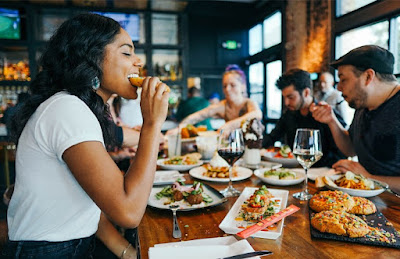Grocery
Stores: More Than Just Sticker Shock
Food
Fact: The grocery food index rose 0.3% in June — mirroring May’s
increase — with notable price hikes in essentials like coffee, beef, and fresh
produce.
Grocery
stores have long been pillars of American food culture, evolving from
mom-and-pop markets to supermarket giants and digital-first fulfillment hubs.
But while food-at-home inflation trails restaurant inflation, the pressure is
mounting. According to NIQ
(formerly NielsenIQ), unit sales in U.S. grocery stores have declined by
over 2% year-over-year, even as dollar sales inch upward — a clear sign of shrinkflation,
smaller basket sizes, and hyper-strategic buying.
How Consumers Are Cutting Back
·
Downshifting Brands:
Private labels are no longer seen as compromises. In fact, 85% of shoppers now
consider store brands to be equal or better in quality than national
brands, according to FMI. Store brand sales surged by $9 billion in 2024,
reaching a record $271 billion, driven by innovation in categories like
plant-based meals, global flavors, and clean-label snacks.
·
Fewer Trips:
Weekly runs are evolving into biweekly hauls. According to Inmar Intelligence, trip frequency
declined by 7% in the past year, while consumers increasingly rely on apps
and digital circulars to pre-plan meals around loyalty perks, digital coupons,
and BOGO events.
·
Reduced Basket Size:
"Just-in-time" shopping is in. With more Americans preparing two
to three mini-meals per day, the demand for fresh, portioned, and snackable
goods is surging. Small-format produce (like mini avocados and snackable
cucumbers), single-serve protein portions, and ready-to-use kits are
leading sales growth.
Restaurants:
Menu Prices Climb, Diners Step Back
Food
Fact: Restaurant prices have increased for 27 straight months.
In June, full-service menu prices jumped 0.5%, while limited-service
edged up 0.2% — outpacing grocery inflation yet again.
Even
as foot traffic stabilizes, consumer behavior is shifting. The National
Restaurant Association reports that 58% of adults are eating at restaurants
less often than they did a year ago, with middle-income households pulling
back the most. Geographic disparities are also growing: full-service menu
prices in the South and West are up over 4% year-over-year, compared to
2.8% in the Northeast.
How Diners Are Saving
·
Trading Down:
Quick-service and fast-casual chains — particularly those with digital value
menus and family bundle promotions — are gaining traction. McDonald's $5
Meal Deal and Chipotle’s loyalty boosts are prime examples of how brands are
recalibrating to meet price sensitivity.
·
Skipping Sides & Extras:
High-margin items like beverages, apps, and desserts are on the chopping block.
Toast data shows that 45% of diners now order fewer extras compared to
2023, prompting restaurants to redesign menus with modular pricing and
more value combos.
·
Dining Out Less Often:
Dining is reverting to its pre-2010 pattern — a "treat behavior"
rather than a regular habit. Restaurants are investing in experience enhancers:
live music, chef-curated menus, and loyalty events to keep the emotional pull
strong.
Convenience
Stores: Quick Stops, Slower Sales
Food
Fact: In 2024, convenience stores — typically resilient during
inflation — are feeling the squeeze. Foot traffic is down, and the average
basket size has decreased by 6.2%, according to NACS.
Long
seen as the go-to for impulse snacks and emergency fuel, convenience stores are
struggling to retain their edge. Even loyal C-store shoppers are replacing
hot grab-and-go items with value-packaged snacks and protein bars purchased
in bulk at grocery clubs.
How C-store Habits Are Changing
·
Reducing Grab-and-Go Purchases:
Prepared foods are losing steam. Sales of roller-grill items like taquitos and
hot dogs are down 8%, while shelf-stable snacks like jerky and trail mix
hold steady.
·
Fuel-Only Visits:
With gas prices rising, one in four C-store customers are no longer entering
the store after fueling — a sharp increase from the 17% recorded just two
years ago.
·
Seeking Promotions:
Loyalty programs and digital deals now drive more than 30% of in-store
purchases, up from 18% in 2021. Successful chains like Casey’s and Wawa are
investing heavily in app-based rewards to retain high-frequency customers.
What
Comes Next: Grocerants and Smaller Meals
According
to Steven Johnson, the Grocerant Guru® at Foodservice
Solutions®, hybrid foodservice — grocerants — are set to redefine
convenience and value. These in-store kitchens serve restaurant-quality
meals without delivery fees or tips, perfectly aligned with
inflation-conscious households.
Grocerants
now account for $43 billion in annual revenue, with growth driven by
health-conscious grab-and-go meals, customizable hot bars, and global flavors
like Korean BBQ bowls and Mediterranean mezze kits.
“Consumers
are building meals around snacks, bundling components, and seeking
flexibility,” Johnson says. This unlocks opportunity for:
·
Meal Deals in Grocery Stores:
Mix-and-match bundles (entrée, side, drink) that rival fast-food combos in both
price and prep time.
·
Snackable Restaurant Offerings:
Shareable, snack-size portions — like sliders, bao, and flatbreads — that feel
indulgent but don’t stretch the wallet.
·
Cross-Channel Innovation:
Think restaurant-branded frozen meals on grocery shelves (e.g., Panera soups,
PF Chang’s bowls) or grocery-exclusive LTOs tied to digital restaurant loyalty
apps.
Final
Bite: A Cautious Appetite
While
inflation has cooled from its 2022 peak, its legacy still shapes the way
Americans eat. The narrowing price gap between grocery and restaurant meals is
forcing a rethink — not just of where consumers eat, but how they
eat.
From
the rise of private labels and modular meals to hybrid
channels like grocerants and branded retail products, brands are being
challenged to deliver value, trust, and innovation — not just
affordability.
As
Johnson puts it:
“Success leaves clues. Today’s clues point to smaller meals, smarter choices, and hybrid solutions.”
Are you ready for some fresh ideations?
Do your food marketing ideas look more like yesterday than tomorrow? Interested
in learning how our Grocerant Guru® can edify your retail food brand while creating a platform
for consumer convenient meal participation, differentiation
and individualization? Email us
at: Steve@FoodserviceSolutions.us or visit: us on our social media sites by clicking one of the
following links: Facebook, LinkedIn, or Twitter







No comments:
Post a Comment